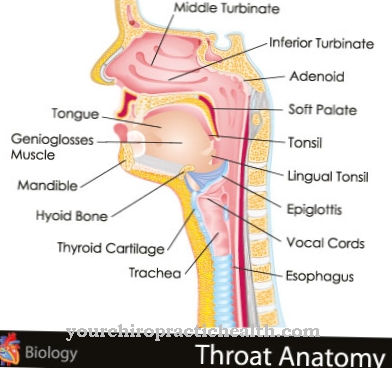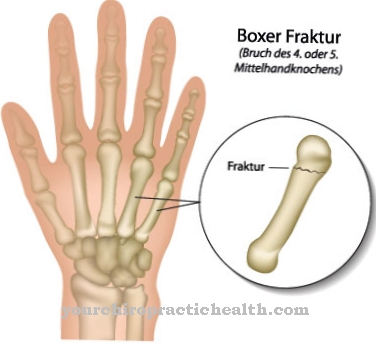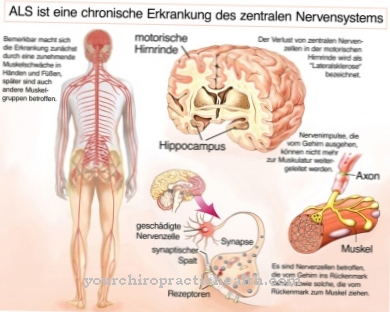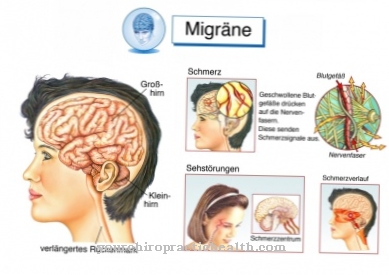A infection refers to the body's defense against invading microorganisms such as viruses, bacteria or fungi. This results in infectious diseases with and without clinical symptoms. The range of infectious diseases is very large and ranges from common childhood diseases to serious infections that threaten life.
What is an Infection?

© Siberian Art - stock.adobe.com
Infection is caused by the attack of microorganisms on the body. The pathogens multiply quickly and spread throughout the body. The body tries to fight off the spread and fight the pathogens, which causes an infection.
Not all of the bacteria around us make us sick. In the intestines or on the skin, they even ensure that we stay healthy and digestion is functioning properly.
Most infections run in healthy people with a good immune system and only mild symptoms. The immune system recognizes the attacker and fights them. Harmless germs are permanently on our skin, in the digestive tract or on the sexual organs and do not cause any damage to healthy people.
If the person affected is weakened by another illness, his organism becomes unbalanced. There is a defense reaction that weakens the organism. Depending on how strong the immune system is, different symptoms appear. If the defense reaction is too weak, the microorganisms spread further, are transferred to important organs via the bloodstream and lead to generalized sepsis.
causes
Germs are everywhere in our environment and can get into the body in a variety of ways. We pick them up when swallowing, touching organic waste, cutting our fingers, sneezing or through hand contact and droplet infection with infected people. There is also a risk of infection during operations.
The immune system protects us from infections because we are constantly attacked by viruses and bacteria. If it is weakened or the number of aggressive germs is too high, the defense has no chance. An infectious disease develops. Allergies, infections and autoimmune diseases weaken the immune system.
The defense system of the human organism against external attacks is, however, complex. On the one hand, we have anatomical barriers such as the mucous membranes, the first line of defense against attacks. Contrary to popular belief, excessive hygiene does not protect against infections, but makes us more susceptible because the natural barrier is destroyed.
The second instance is the body's immune system. Everything that appears threatening to the body is destroyed by the immune cells. The defense reaction usually manifests itself with a fever. The normal human temperature is between 36 and 37.5 ° C. From 38 ° C one speaks of fever. Above 41 ° C, the body temperature becomes life-threatening as cells are destroyed. Fever is a very important, but by no means always present symptom of an infectious disease.
The immune system also has a memory. After an infection, the immune system becomes stronger because the body can remember certain germs. This protective mechanism works just like a vaccination. The vaccination leads the body to believe that it is infected with germs, so that the body develops antibodies. If the person is actually attacked by this pathogen later, the antibodies react to it. Over time, however, this memory fades.
In the case of allergies, the body's own defense system is not fully functional. In the case of a house dust mite allergy or hay fever, the defense is directed against substances that are basically harmless. Most people who breathe these substances do not feel anything. An allergic person has no protective antibodies and shows allergic symptoms. In this case, the immune system does not have the ability to learn a defense reaction and to react to the substances in the future.
Symptoms, ailments & signs
Infectious diseases are caused by pathogens and they occur in a very wide range. Infectious diseases range from a simple cold to typical childhood diseases such as measles, chickenpox and rubella to HIV or tropical diseases. Colloquially they are also called infections, but should not be confused with an infection. Infection is the inflammation of a wound.
Infectious diseases are accompanied by a wide range of symptoms and vary over time. They are differentiated according to the origin of the pathogen, the entry point of the pathogen, the course of the infection or the route of transmission. The extent of the infection can also be a distinguishing criterion.
Infectious diseases are most commonly caused by bacteria. For example, bacteria are responsible for tuberculosis, meningitis, cholera, plague and borreliosis. Whooping cough and diphtheria are also transmitted by bacteria and can be life-threatening for young children. Tetanus is triggered by very resistant bacteria.
Fungal diseases are often found on the eyes, oral mucous membranes and genitals.
Viruses cause all classic childhood diseases such as hepatitis B, the flu, runny nose, many colds and AIDS. Hepatitis B is a contagious liver disease that quickly develops into chronic disease. Shingles is caused by the same virus as chickenpox, but it is much more dangerous.
Depending on whether fungi, viruses or bacteria are the trigger, a different therapy is used. For treatment, the pathogen must first be determined. You can protect yourself against some pathogens with a vaccination.
The most sustainable way, however, is to protect yourself with a strong immune system that can be positively influenced. We can strengthen it through a balanced diet with fresh fruit and vegetables and exercise in the fresh air. In addition to vitamins, the intake of minerals such as zinc, iron, calcium, potassium and selenium is also important.
Bacterial infections are often dangerous and are often treated with antibiotics. Antibiotics do not help with infections caused by viruses. However, there are other drugs that can stop the virus from multiplying.
Complications
In most cases, infection is caused by bacteria, which can cause various complications. Often, severe and long-lasting headaches occur in connection with an infection, which can only be relieved with the help of appropriate medication. Other possible side effects are an increased temperature, fever, nausea, vomiting and severe sore throat or difficulty swallowing.
Those who leave these individual clinical pictures without treatment are of course running a great risk, so that a significant worsening can be expected. However, if you resort to treatment with the right medication at an early stage, you can significantly alleviate and combat the symptoms mentioned above.
However, if you do not initiate treatment, you must expect considerable complications. The symptoms will increase significantly within a short time, so that the infection will spread throughout the body. It is not uncommon for severe flu to develop in this context, which without any treatment represents a great danger.
Anyone who suffers from a bacterial infection should always resort to drug treatment. This is the only way to avoid serious complications and complaints. In the absence of treatment, the above complications will be significantly worse.
Aftercare
Follow-up care for an infection depends on the specifics of the infectious disease you have suffered. Infections of the skin, gastrointestinal tract and upper respiratory tract, for example, show how different aftercare after an infection can look. While superficial wound infections require rapid regeneration by avoiding contamination, the restoration of the immune system is often an important factor in aftercare after internal infections.
This includes getting enough sleep, eating a healthy diet and drinking enough water. Refraining from nicotine and alcohol is advisable. In the case of infections of the respiratory tract, aftercare can also consist of ensuring that the air is fresh, for example by ventilating the rooms consistently or taking regular walks. In the case of gastrointestinal infections, the body often has to slowly get used to food again.
Small portions and avoiding alcohol and nicotine are advisable during the regeneration phase. In infections that have been treated with antibiotics, those affected often complain of a disturbed intestinal flora. Here, patients ideally pay attention to sparing food that should include avoiding spicy or fatty foods. Yoghurt products, possibly taken in consultation with the doctor, can help to rebuild the intestinal flora.
Exercise caution when doing sports. These should only be resumed when the infection has completely subsided and the patient is productive again.
Outlook & forecast
The prognosis for infection is favorable. When using medical care, the spread of the pathogen is stopped as quickly as possible. Then the triggering germs die and are transported out of the organism. The regeneration begins and the body's own strength is gradually built up. With a stable immune system and adequate protection, you will be completely free of symptoms within a few weeks.
Delays in the recovery process are to be expected if the patient already has another illness or does not have a healthy immune system. Naturally, this occurs in children or elderly patients. With an unhealthy lifestyle, impairments must also be expected. Without adequate medical treatment, the prognosis for these people worsens.
In severe cases it can lead to premature death, as the organism is weakened and can no longer recover sufficiently due to the various impairments. The pathogens spread almost unhindered and the organism ultimately surrenders to the multitude of germs.
Adult people who have a healthy lifestyle and have no other illnesses usually experience relief from the symptoms even without medical treatment. Taking into account various self-help measures and with the support of known home or natural remedies, healing can be documented in a large number of those affected.
You can do that yourself
What a patient can do himself in the case of an infectious disease depends on the nature of the symptoms. The most widespread are infectious diseases that are associated with coughs, hoarseness, runny nose, headaches and fever and are usually subsumed under the collective term "cold". If you have a cold, you should, if possible, treat yourself to a few days of rest, plenty of drinking, keeping yourself warm and eating healthy, vitamin-rich, easily digestible food. The intake of vitamin C can additionally strengthen the immune system. Over-the-counter drugs from the pharmacy help against minor side effects such as a cough or runny nose. However, as soon as the symptoms get worse, a doctor should be consulted immediately.
In autumn and winter there is also a regular wave of flu. The symptoms are often very similar to the common cold, but the flu is far more aggressive and the course is usually much more severe and protracted.In addition, flu is usually highly contagious. For this reason alone, the workplace should not be visited and a doctor should be consulted instead. Home remedies can also help against the high fever that often accompanies the flu. Cold calf compresses in particular provide quick relief. Vaccinations are also offered against many flu pathogens, which people belonging to a risk group should also make use of.
When should you go to the doctor?
A doctor is needed if the person concerned has a feeling of illness. Since in most cases the symptoms increase rapidly within a short time, a doctor should be consulted as soon as the first signs appear. If you experience a high temperature, fever, sweating, tiredness, vomiting or dizziness, it is advisable to consult a doctor. Stomach problems, indigestion, diarrhea, or nausea should be investigated and treated. If the loss of appetite persists, general weakness, diffuse pain or decreased performance, a doctor must be consulted. If sleep problems set in, cardiac rhythm disorders, listlessness or apathy, a doctor should be asked for help.
If you have a racing heart, increased or decreased blood pressure, or if you feel cold or hot, you need to see a doctor. Changes in the appearance of the skin, swelling of the skin or redness should be examined and treated. If you have a headache, listlessness, reddening eyes, breathing difficulties or persistent coughing, see a doctor. If the person concerned suffers from colds, difficulty swallowing, sexual dysfunction or irritation of the skin, a doctor should be consulted. If pus, open wounds or psychological problems develop, we recommend clarifying the symptoms. If existing symptoms increase or if they spread throughout the body, a doctor should be consulted immediately.
























.jpg)



